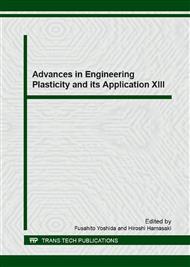p.439
p.445
p.451
p.456
p.465
p.471
p.477
p.483
p.489
Effects of Non-Associated Flow Rule on AHSS Shear Fracture
Abstract:
Recently, advanced high strength steels (AHSSs) have been widely applied to the structural parts of vehicles thanks to their good combination of strength and ductility. When one makes parts with AHSSs, however, fractures in sharp corners of the parts are frequently observed below forming limit, which is normally defined by strain based FLC(Forming Limit Curve). This phenomenon is well-known as “Shear Fracture”. Recent researches point out that additional numerical techniques should be considered in order to predict it accurately. Kim et al. [1] suggested that shear fracture can be predictable with continuum-based finite elements rather than conventional shell elements, and more constitutive informations for large strain thermo-mechanical simulation are needed to improve accuracy. Luo and Wierzbicki [2] showed that shear fracutre in stretch-bending test can be fully characterized by proposed MMC(Modified Mohr-Coulomb). This paper shows that solid-shell approach based on hyper-elastoplastic material model enables one to properly predict shear fracture pheonomenon without any special failure criteria. Furthermore, the effects of non-associated flow rule on shear fracture will be also discussed with several numerical examples.
Info:
Periodical:
Pages:
465-470
Citation:
Online since:
December 2016
Authors:
Price:
Сopyright:
© 2017 Trans Tech Publications Ltd. All Rights Reserved
Share:
Citation:


